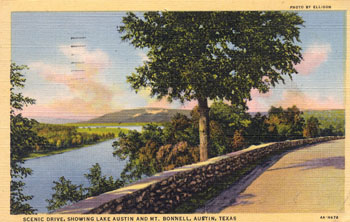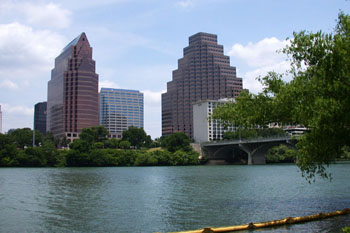
|
|
The Colorado River
A project to bring up to 150,000 acre-feet of water from the lower Colorado River to San Antonio was included in every version of the State Water Plan issued between 2000 and 2007, and the 2011 version includes an off-channel reservoir that would be developed by SAWS and the Lower Colorado River Authority and bring 90,000 acre-feet to San Antonio by 2030 (see the 2011 plan summary). Before that, a Texas Water Development Board study recommended piping water from the Austin area toward San Antonio. Another option was tapping the Colorado at Columbus and pumping water along Interstate 10 to San Antonio. However, SAWS' 2012 Water Management Plan does not include a Colorado River component, so it appears unlikely there will be any water from the Colorado supplementing San Antonio's supplies anytime soon. SAWS listed an unspecified 'Future Regional Water Supply Project' to be developed after 2040, but no one can say at this time what that might be. A Brief Historical Sketch Although water planners have long envisioned a Colorado River project supplying the San Antonio region, there has always been opposition to the idea amongst Colorado basin residents. When the idea began to be seriously pursued in 1995, residents of the Highland Lakes area started organizing to squelch any planned diversions of Colorado River water to San Antonio (1). By March '96, Highland Lakes area residents had organized the "Oppose the San Antone Hose" campaign, including a letter-writing campaign to then-Governor Bush. Residents feared that diversions would cause lake levels to drop and devastate their recreation-based economy (2). In February 2000, about 300 people attended a meeting of the Water Planning Group and suggested that San Antonio could choke on its own dust before they got a drop of Colorado River water (3). Many were critical of San Antonio for decades of poor water planning. Advocates of such a project said that opponents needed to consider the big picture and how the region is one economic entity. They said solutions could be found that would foster economic growth and development for all of South Texas. In January 2001, it seemed that regional cooperation had prevailed. The San Antonio Water System Board and the Lower Colorado River Authority reached a deal that would have allowed San Antonio to purchase up to 150,000 acre-feet of water for up to 80 years, ensuring San Antonio's water supply for most of the 21st century (4). In exchange, San Antonio would pay for development of an additional 180,000 acre-feet of water supplies to be used in the Colorado basin, mostly for agriculture. The project was initially estimated to cost up to $1 billion, which included building a pumping facility to divert floodwaters from the Colorado, a 170-mile pipeline, several storage ponds, and a treatment facility. Water would then be used to grow local crops and also be sent to San Antonio. SAWS and the LCRA agreed on a seven year study period to determine the environmental effects of the project such as the impact on sensitive bays and estuaries. LCRA general manager Joe Beal said the project would benefit farmers near the Texas coast because they might otherwise lose their water to growing towns along the river and money from San Antonio could pay for conservation projects that could keep them in business. Also, Beal said that towns around the Highland Lakes would benefit because lake levels would not have to drop as much to satisfy downstream needs. Representative Bobby Cook of Eagle Lake said "This water sharing plan represents a new chapter in state water planning, one in which citizens and their leaders have decided to cooperate rather than fight over water." (5). To make the deal possible, the Texas Legislature had to approve a new law to allow the LCRA to sell water outside its boundaries. The LCRA had been prohibited from doing so by the law that created it. In Februrary 2001, representatives of the Environmental Defense Fund, the National Wildlife Federation, and the Sierra Club said they would not oppose the proposed project if it was clear that environmental concerns would be adequately addressed. They asked the project not be hurried forward until studies determine how much water could be removed from the Colorado without reducing freshwater flows into Matagorda Bay below critical levels. SAWS' officials said the potential environmental impacts would be studied and factored in before the project was advanced, and the House Committee on Natural Resources unanimously approved for consideration by the full House a bill that would authorize the LCRA to proceed (6). In May 2001 the bill was approved by the House and sent to Governor Perry for his signature (7). With the necessary law on on the books, the Board of the San Antonio Water System approved an 87-year contract with the Lower Colorado River Authority on February 18, 2002 (8). A few days later, the Board of the LCRA also approved the pact (9), and on February 27 both agencies formally signed it (10). An array of studies were planned, and in February of 2004 the SAWS Board approved a $43 million, multi-year schedule of environmental, engineering, and social studies to completely evaluate the project's feasibility (11). Many persons, including SAWS Board trustees, expressed concern about the cost of the project, but the Board decided to proceed knowing it could drop out of the project if initial studies showed the amount of water projected isn't available or there would be environmental problems in the Colorado River or Matagorda Bay. The schedule included $9.1 million for evaluating impacts on Matagorda Bay, $2.3 million for other environmental studies, $4.2 million to study groundwaters that would be used for agricultural during droughts, and $3.2 million for studying how to achieve conservation in irrigation districts. If studies showed the project to be feasible, it could enter an implementation phase, but water would not actually be delivered to San Antonio until after 2020. In March of 2005, the Boards of SAWS and LCRA met to review progress, and LCRA general manager Joe Beal noted "At this point in time, from an environmental standpoint, there's no real project stoppers that have been identified." By late 2008, studies suggested the maximum yield of the project would be about 90,000 acre-feet instead of 150,000. They also concluded that in order for San Antonio to get that much water, rice farmers would have to draw on groundwater supplies in 49% of all years. And the cost had risen to over $2 billion. In January of 2009, the Board of the LCRA, which has all been replaced since the deal was initially approved, adopted new policies that would not allow agricultural users to rely on groundwater supplies. It also decided to keep 50,000 acre-feet of water in reserve in the Highland Lakes above Austin for other customers in the area. In response, SAWS asked for spending on studies to be stopped and in a letter to the LCRA, SAWS President Robert Puente said "the unilateral action of the LCRA board has summarily placed in question the project's continued viability." (13) In April of 2009, the LCRA wrote a letter to the Lower Colorado Regional Planning Group that said preliminary studies had concluded that no water could be made available to San Antonio, and the project appeared dead. LCRA spokesman Robert Cullick said "It looks like we're growing in this region a lot faster than had been projected in 2006. At the end of the day, we can't meet all the requirements with the water project as originally envisioned. The outcome of that is no water is available for San Antonio." SAWS CEO and former legislator Robert Puente said he believed the deck was stacked against San Antonio by the LCRA Board decisions in January and "It wasn't the contract or studies that said the yield is zero to San Antonio." (14) In May of 2009, the San Antonio Water System Board of Trustees declared the LCRA to be in breach of contract. SAWS Chairman Alex Briseno said "I think unfortuately we don't have a choice. We feel that we have been wronged." (15) The dispute centered on the LCRA's use of population and water demand projections that were prepared by an outside consultant. The contract specifies the numbers should come from the Region K water plan (Region K is the Lower Colorado region). SAWS also disputed the LCRA Board's January actions that changed agricultural use policies and allocated more water for reserve in the Highland Lakes. In August of 2009 the San Antonio Water System filed a lawsuit seeking $1.23 billion from the LCRA. SAWS CEO and former lawmaker Robert Puente said "We're very upset. We have put at least $40 million into this project, and as recently as the summer of 2006 everything was going according to plan. All of a sudden they decide to have a new set of demand numbers by studies that are not part of the agreement." (16) In February of 2010, Travis county District Judge Stephen Yelenosky ruled that LCRA has sovereign immunity and cannot be sued by SAWS (17). SAWS expressed deep disappointment with the ruling, saying it "inserts confusion and uncertainty in contracts between governmental agencies and future efforts to address the state's water needs." On February 17 SAWS filed a notice of intent to appeal Judge Yelenosky's decision. Robert R. Puente, SAWS President and CEO, said “Unfortunately, with the trial court’s ruling, LCRA’s conduct and actions have yet to be addressed – and may never be considered without this appeal.” (18). In July of 2011, the Texas 3rd Court of Appeals reversed Judge Yelenosky's decision, saying that LCRA could indeed be sued. At a minimum, SAWS hoped to recover $53 million in ratepayer monies expended so far on studies and other costs related to the project (19). In October of 2011, the issue was settled when LCRA agreed to pay SAWS $30 million of what it had spent. The settlement ended the lawsuit, and the contract between the two agencies was officially terminated (20).
|
||||||||
|
Materials used to prepare this section:
(1) "Group takes stand on water" San
Antonio Express-News, December 24, 1995. |
||||||||

